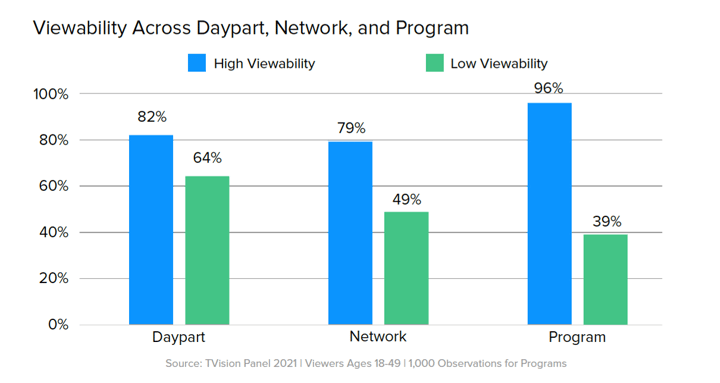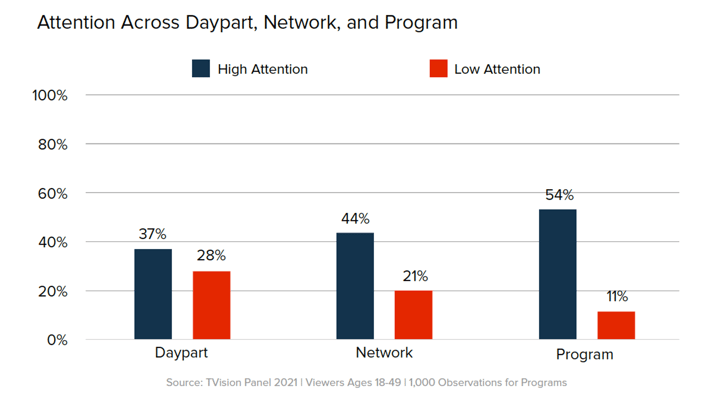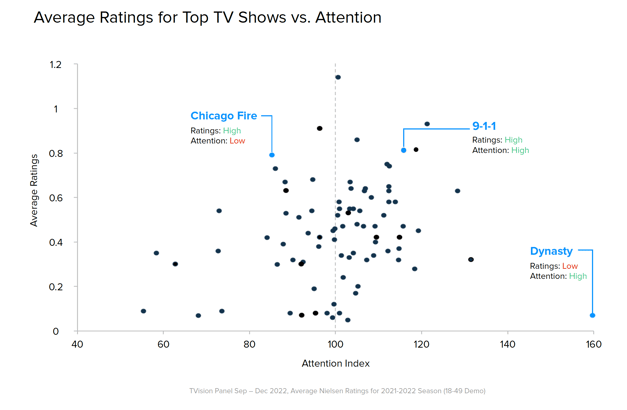As marketers gear up for this year's all-important Upfront season, they're faced with a fundamentally transformed TV landscape. The demand for at-home entertainment has resulted in higher quality programming across a wider array of apps, networks, and channels. Streaming TV audiences, who had previously leaned into commercial-free viewing, now spend more time watching ad-supported video-on-demand than ad-free subscription services.
Perhaps the most dramatic change is in how we measure and value TV itself. Between recent calls for more reliable standards of measurement and alternative data-driven currencies emerging from companies like VideoAmp and iSpot, the market seems poised to finally adopt more sophisticated and meaningful metrics for evaluating TV ad time.
These changes mean Upfront planning is more complex than ever. That's why TVision and Mediahub Worldwide have compiled our 2022 Upfront Planning Guide featuring must-know insights and tips for how to tackle this year's media buys using Attention as a reliable metric for cross-media valuation and measurement. By making smart investments that factor in audience attention, advertisers can ensure their budgets deliver more value than ever before.
Read below for a sneak peek of some attention tips from our new Upfront Planning Guide and sign up today for a free 1:1 planning workshop to help you maximize the impact of your Upfront. Marketers who sign up will receive a custom Upfront diagnostic and action plan, including a preview of their top five opportunities for attention.
We all know even the best TV ads are sometimes shown to audiences who are simply not paying attention. To date, the industry has solved this intuitively—for example paying premium CPMs for Primetime when audiences are less likely to be distracted. But these simple proxies don’t reflect the real-world nuance of audience attention—causing ad impressions to be under—or over-valued.
If you're curious, TVision reports Attention by measuring the amount of time that viewers were engaged with the ads, with their eyes on the TV screen. Attention metrics require the viewer to have had their eyes on the screen for two or more seconds. In a world where people are constantly multi-tasking, getting and keeping consumer attention should be a priority for any advertiser.
Our data shows that Attention varies dramatically across dayparts, networks, and programming. In fact, there are programs across all dayparts that deliver higher attention, and usually at lower costs, than some primetime spots.
In this chart, we illustrate the significant variances between high and low viewability and attention media. When evaluating media opportunities, marketers may first want to consider viewability. When looking at Viewability, the difference between placements is quite pronounced across the board. For example, some programs keep viewers in the room for as much as 96% of all ad impressions or as little as 39%.

Next, assuming that the media is viewable, it’s important to look at how effectively these placements keep viewers’ eyes on the screen. Here, we see a nearly 5x difference in attention with the highest performing program at 54% attention and the lowest at 11%.
 Savvy marketers can use Attention data in their Upfront planning & negotiations to more accurately value media opportunities and ensure they’re directing budgets to impressions where their ads may actually be seen by people in the room.
Savvy marketers can use Attention data in their Upfront planning & negotiations to more accurately value media opportunities and ensure they’re directing budgets to impressions where their ads may actually be seen by people in the room.
For advertisers looking for some surefire programs to grab attention next year, TVision compiled a list of the primetime shows that captured the most attention in all of 2021 across broadcast and cable.
For those considering which CTV opportunities to prioritize during Upfront, here are the top apps for Ad Attention and programs for Co-Viewing—a multiple that can help marketers and platforms better value their CTV ad inventory.
Ratings have long served as the primary currency during the Upfront. But ratings only tell part of the story. In today’s distracted environment, ratings alone don’t mean people are in the room, paying attention. By layering TVision’s person-level engagement data on top of ratings, advertisers can find shows that truly deliver on the promise of a large and engaged audience.
In the chart below, we’ve taken the shows with the highest average ratings so far in the 2021-2022 season by viewership and plotted them against our Attention Index. While shows toward the top of the chart score high in terms of ratings, those that also fall to the right of our Attention Index average are marketers’ best bets--keeping viewers’ eyes on the screen during commercial breaks. For instance, FOX's 9-1-1 and NBC's Chicago Fire both draw in a large audience and garner high ratings, but 9-1-1 is more likely to keep audiences engaged. Some lower-rated shows with high Attention may also be worth a second look. The CW’s Dynasty indexed among the highest for Attention despite comparatively modest ratings, providing marketers a potentially lower-cost opportunity to reach a smaller, yet highly engaged audience.

Savvy marketers can use attention data in their Upfront planning & negotiations to more accurately value media opportunities and ensure they’re directing budgets to impressions where their ads may actually be seen by people in the room.
While streaming television gets a lot of the industry buzz, traditional linear television viewing still represents the majority of all TV watching in the United States. Linear advertising also typically secures higher levels of attention and viewability than CTV averages. This is likely due to several contributing factors. For instance, CTV viewers may be less accustomed to watching ads or they’re seeing the same ads on repeat due to ad oversaturation on CTV platforms. However, it’s worth noting that viewers are more likely to be watching CTV content with friends and family. CTV typically sees higher co-viewing averages than linear. To learn more about the CTV opportunity, check out our recent State CTV Report.

The Upfront may be transforming, but attention data provides the transparency needed to navigate the changing landscape with confidence. Both marketers and media sellers can improve the Upfront process by better understanding the value of each impression. For more actionable insights, download the full Upfront Planning Guide.
TVision is offering free 1:1 planning workshops to help you maximize the impact of your Upfront. Marketers will receive a custom Upfront diagnostic and action plan, including a preview of their top five opportunities for attention. Sign up today to claim your spot.